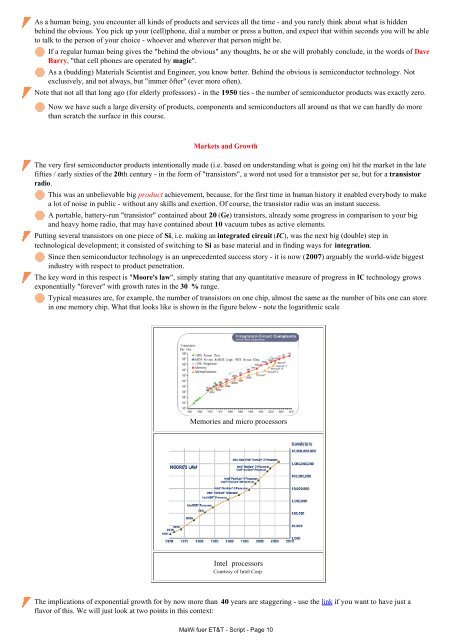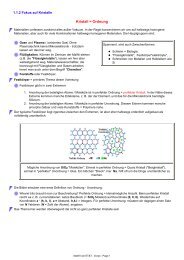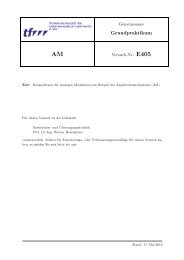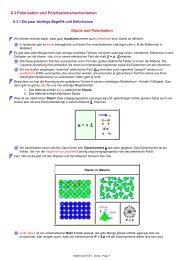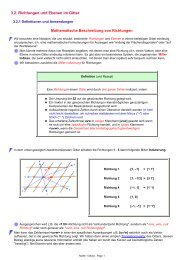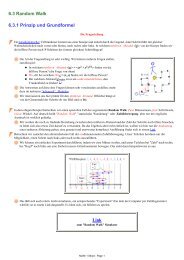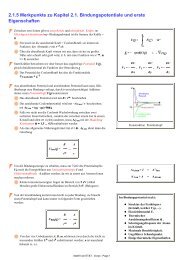- Seite 1 und 2: 1. Einleitung 1.1 Grundlagen der Ma
- Seite 3 und 4: Wir zerlegen mal gedanklich ein Not
- Seite 5 und 6: Einkristall Perfekter Kristall (vor
- Seite 7 und 8: 1.1.3 Grundlagen und Praxis der Mat
- Seite 9: 1.2. Materialwissenschaft und ET&IT
- Seite 13 und 14: Wir betrachten ein beliebiges Produ
- Seite 15 und 16: 1.2.4 Merkpunkte zu Kapitel 1.2. "M
- Seite 17 und 18: Semiconductor Technology; Kapitel 1
- Seite 19 und 20: 2. Bindungen und einige Eigenschaft
- Seite 21 und 22: Aus "Asterix und die Normannen", Co
- Seite 23 und 24: Jetzt kommt der entscheidende Schri
- Seite 25 und 26: Nebenbei haben wir noch unsere Haup
- Seite 27 und 28: 2.1.2 Bindungspotentiale, Federn, u
- Seite 29 und 30: Der E-Modul wird bei den elektrisch
- Seite 31 und 32: UBindg = - A r n + B r m Bindungspo
- Seite 33 und 34: 2.1.3 Bindungspotentiale und weiter
- Seite 35 und 36: Falls die Atome um ihre Gleichgewic
- Seite 37 und 38: Das bedeutet, dass mit einer Kraft
- Seite 39 und 40: 2.1.4 Vom Bindungspotential zum Kri
- Seite 41 und 42: 2.1.5 Merkpunkte zu Kapitel 2.1. Bi
- Seite 43 und 44: Fragebogen Einfache Fragen zu 2.1 H
- Seite 45 und 46: Was kann man sofort zu Eigenschafte
- Seite 47 und 48: Sie kann in mehreren Arten vorkomme
- Seite 49 und 50: Wie ist das mit den Eigenschaften?
- Seite 51 und 52: Diese Dipol - Dipol Wechselwirkung
- Seite 53 und 54: 2.2.5 Merkpunkte zu Kapitel 2.2: Bi
- Seite 55 und 56: 2.3 Essenz der Quantentheorie 2.3.1
- Seite 57 und 58: Elektronen in einem System dürfen
- Seite 59 und 60: 2.3.2 Wellenfunktion und Schröding
- Seite 61 und 62:
Wir könnten jetzt einen Potentialt
- Seite 63 und 64:
In Worten: Die Wahrscheinlichkeit d
- Seite 65 und 66:
2.3.3 Zustände, Wellen, Energie un
- Seite 67 und 68:
Falls jemand die Übungsaufgabe 2.3
- Seite 69 und 70:
Elektron als Wellenpaket zu verschi
- Seite 71 und 72:
Klassisches Teilchen und Mauer Mate
- Seite 73 und 74:
2.3.4 Merkpunkte zu Kapitel 2.3: Es
- Seite 75 und 76:
2.4 Ergänzende Quantentheorie 2.4.
- Seite 77 und 78:
2.5 Zusammenfassungen zu Kapitel 2:
- Seite 79 und 80:
In metallischen Bindungen werden ü
- Seite 81 und 82:
2.5.2 Was man wissen muss Minimalke
- Seite 83 und 84:
Formeln Coulombpotential UCou = e 2
- Seite 85 und 86:
3. Idealer Kristall 3.1.1 Kristall
- Seite 87 und 88:
Wichtige Gitter und Kristalle Wir m
- Seite 89 und 90:
3.1.2 Notation von Richtungen und E
- Seite 91 und 92:
3.1.3 Kristall und Eigenschaften Un
- Seite 93 und 94:
3.2 Einige wichtige Kristalle 3.2.1
- Seite 95 und 96:
3.2.2 Kristallgalerie Einfache Kris
- Seite 97 und 98:
Relativ simples Protein als Basis;
- Seite 99 und 100:
3.3 Zusammenfassungen zu Kapitel 3
- Seite 101 und 102:
3.3.2 Was man wissen muss Kristall
- Seite 103 und 104:
4. Realer Kristall 4.1 Was sind Kri
- Seite 105 und 106:
Nulldimensionale Defekte (auch "Pun
- Seite 107 und 108:
4.1.2 Merkpunkte zu Kapitel 4.1: Wa
- Seite 109 und 110:
Das war's. Nicht so schwer. Die Fra
- Seite 111 und 112:
4.2.2 Diffusion mit atomaren Fehlst
- Seite 113 und 114:
1. Ja Falls ein "thermodynamisches
- Seite 115 und 116:
Elektrische Felder E, zum Beispiel,
- Seite 117 und 118:
4.2.3 Random Walk und Diffusionslä
- Seite 119 und 120:
4.2.4 Merkpunkte zu Kapitel 4.2 Ato
- Seite 121 und 122:
4.3 Versetzungen, plastische Verfor
- Seite 123 und 124:
Im ersten Schritt legen wir eine "S
- Seite 125 und 126:
4.3.2 Die restlichen Defekte Nochma
- Seite 127 und 128:
4.3.3 Merkpunkte zu Kapitel 4.3: Ve
- Seite 129 und 130:
Es gibt vier Grundtypen atomarer Fe
- Seite 131 und 132:
Materialentwicklung Strukturwerksto
- Seite 133 und 134:
Zahlen alt Größe Zehnerwert Besse
- Seite 135 und 136:
5. Grundzüge von Thermodynamik und
- Seite 137 und 138:
Momentaufnahme mit ganz kurzer Beli
- Seite 139 und 140:
Wie ist das nun bei nicht-klassisch
- Seite 141 und 142:
5.1.2 Der 2. Hauptsatz und die Entr
- Seite 143 und 144:
Für eine "gemessene" Unordnung ben
- Seite 145 und 146:
n N! Die Entropieformel lautet dami
- Seite 147 und 148:
5.1.3 Merkpunkte zu Kapitel 5.1: Sy
- Seite 149 und 150:
G(n) = E0 + n · E F - kT · ln N!
- Seite 151 und 152:
5.2.2 Berechnung der Leerstellenkon
- Seite 153 und 154:
Wir können diese ausführliche Bet
- Seite 155 und 156:
5.3 Zustandsdichten und Verteilungs
- Seite 157 und 158:
Klassische Teilchen gibt es "eigent
- Seite 159 und 160:
Wir haben aber ein kleines Problem,
- Seite 161 und 162:
f(E,T) ≈ exp - E - EF Das ist die
- Seite 163 und 164:
Der Graph der Fermiverteilung sieht
- Seite 165 und 166:
Alle Systeme folgen einem einfachen
- Seite 167 und 168:
5.4.2 Was man wissen muss Begriffe
- Seite 169 und 170:
Zahlen neu Größe Zehnerwert Besse
- Seite 171 und 172:
Mech. Spannung σ, Dehnung ε, E-Mo
- Seite 173 und 174:
6. Dielektrika und Optik 6.1 Warum
- Seite 175 und 176:
6.1.2 Was wir über Dielektrika ger
- Seite 177 und 178:
6.1.3 Merkpunkte zu Kapitel 6.1: Wa
- Seite 179 und 180:
Was sind die atomaren Mechanismen d
- Seite 181 und 182:
6.3 Polarisation und Polarisationsm
- Seite 183 und 184:
Im Feld wie eingezeichnet zieht's d
- Seite 185 und 186:
6.3.2 Verallgemeinerung des Begriff
- Seite 187 und 188:
Wirkleistung LW = ω · ε'' · E 2
- Seite 189 und 190:
Wenn wir ein stark vereinfachtes sp
- Seite 191 und 192:
Ohne Feld Mit Feld Die Berechnung d
- Seite 193 und 194:
6.3.4 Merkpunkte zu Kapitel 6.3. Po
- Seite 195 und 196:
6.4 Frequenzabhängigkeit der Diele
- Seite 197 und 198:
6.4.2 Der Frequenzgang der (komplex
- Seite 199 und 200:
Wir wollen eigentlich die Frequenza
- Seite 201 und 202:
Man stelle sich einen Kristall vor,
- Seite 203 und 204:
P(ω) = ∞ ⌠ ⌡ 0 P 0 · exp -
- Seite 205 und 206:
6.4.4 Gesamtschau Die komplette die
- Seite 207 und 208:
6.4.5 Merkpunkte zu Kapitel 6.4: Fr
- Seite 209 und 210:
6.5 Optik mit komplexem Brechungsin
- Seite 211 und 212:
6.5.2 Merkpunkte zu Kapitel 6.5: Op
- Seite 213 und 214:
6.7 Zusammenfassungen zu Kapitel 6
- Seite 215 und 216:
Es gibt neben der mathematisch schw
- Seite 217 und 218:
6.7.2 Was man wissen muss Wir kenne
- Seite 219 und 220:
Damit können wir: Den Real- und Im
- Seite 221 und 222:
Innere Energie U (pro Teilchen) Ent
- Seite 223 und 224:
7. Magnetische Materialien 7.1 Magn
- Seite 225 und 226:
|m| = I · A Das magnetische Dipolm
- Seite 227 und 228:
7.1.2 Dia-, Para-, and Ferromagneti
- Seite 229 und 230:
Der erste Fall wird dann oberhalb e
- Seite 231 und 232:
7.1.3 Merkpunkte zu Kapitel 7.1. Ma
- Seite 233 und 234:
In Worten: Bei einer Blochwand dreh
- Seite 235 und 236:
Komplette Hystereseschleife mit Def
- Seite 237 und 238:
7.2.3 Merkpunkte zu Kapitel 7.2 Fer
- Seite 239 und 240:
7.3 Technische Nutzung des Ferromag
- Seite 241 und 242:
Fragebogen Schnelle Fragen zu 7.3.1
- Seite 243 und 244:
Data storage digital Quantum device
- Seite 245 und 246:
7.3.3 Merkpunkte zu Kapitel 7.3 Tec
- Seite 247 und 248:
Viele ferromagnetische Materialien
- Seite 249 und 250:
7.4.2 Was man wissen muss Wir kenne
- Seite 251 und 252:
Zahlen alt Größe Zehnerwert Besse
- Seite 253 und 254:
Dichte Teilchen bei E n(E) = D(E)
- Seite 255 und 256:
8. Leitfähigkeit und Bändermodell
- Seite 257 und 258:
Bechränken wir uns erstmal auf Met
- Seite 259 und 260:
vD = constant E Das ist eine weiter
- Seite 261 und 262:
Was hat das nun alles mit der Leitf
- Seite 263 und 264:
8.1.3 Die elektrische Leitfähigkei
- Seite 265 und 266:
8.1.4 Merkpunkte zu Kapitel 8.1: Le
- Seite 267 und 268:
8.2 Bändermodell und Materialeigen
- Seite 269 und 270:
Solche Band-Band-Übergänge, induz
- Seite 271 und 272:
8.2.2 Was wir lernen müssen Überb
- Seite 273 und 274:
Wir haben nur die Elektronen im Lei
- Seite 275 und 276:
ne L (T) = ∞ EL - EF ⌠ D(E) ·
- Seite 277 und 278:
8.2.3 Zustandsdichte, Fermiverteilu
- Seite 279 und 280:
Quantenzustand Energie (× Konstant
- Seite 281 und 282:
Wir machen uns das Leben einfach un
- Seite 283 und 284:
8.2.4 Merkpunkte zu Kapitel 8.2: B
- Seite 285 und 286:
8.3 Zusammenfassungen zu Kapitel 8
- Seite 287 und 288:
ne L (T) = ∞ ⌠ D(E) · f(E; EF,
- Seite 289 und 290:
Wir kennen typische Zahlen (für ρ
- Seite 291 und 292:
Permeabilität μr Frequenzabhängi
- Seite 293 und 294:
ω0' = Komplexer Brechungsindex n (
- Seite 295 und 296:
9. Halbleiter 9.1 Ladungsträgerdic
- Seite 297 und 298:
Das können wir nachrechnen - wir b
- Seite 299 und 300:
Halbleiter Ge Si GaAs GaP Energiel
- Seite 301 und 302:
9.1.2 Darstellung der Stromleitung
- Seite 303 und 304:
Ein letzter Punkt: Das Banddiagramm
- Seite 305 und 306:
Damit haben wir zwei neue Fachwört
- Seite 307 und 308:
Das bedeutet, dass die beiden roten
- Seite 309 und 310:
9.1.4 Merkpunkte zu Kapitel 9.1: La
- Seite 311 und 312:
9.2 Vom idealen zum realen Halbleit
- Seite 313 und 314:
9.2.2 Generation, Rekombination, Le
- Seite 315 und 316:
Direkte Halbleiter: L und τ sind k
- Seite 317 und 318:
9.2.3 Merkpunkte zu Kapitel 9.2: Vo
- Seite 319 und 320:
9.3 Raumladungszonen und Übergäng
- Seite 321 und 322:
9.3.2 Oberflächenzustände und Ban
- Seite 323 und 324:
Die Oberfläche ist eindeutig negat
- Seite 325 und 326:
9.3.3 Bandverbiegung und Raumladung
- Seite 327 und 328:
Frage 2: Was ist denn die Dielektri
- Seite 329 und 330:
U = ∆EF - e - Uex Je nach Vorzeic
- Seite 331 und 332:
Entscheidend ist das Banddiagramm f
- Seite 333 und 334:
9.4 Der pn-Übergang 9.4.1 Grundsä
- Seite 335 und 336:
Man könnte natürlich auch sagen:
- Seite 337 und 338:
9.4.2 Ströme im pn-Übergang im Gl
- Seite 339 und 340:
Die nL,V sind die Konzentrationen d
- Seite 341 und 342:
9.4.3 Die Kennlinie des pn-Übergan
- Seite 343 und 344:
jF(Uex) = j0 · exp - ∆EF - eUex
- Seite 345 und 346:
jR ≈ jR(L) + jR(V) Einfacher geht
- Seite 347 und 348:
9.4.4 Merkpunkte zu Kapitel 9.4: De
- Seite 349 und 350:
Vorwärts für + an p-Teil, - an n-
- Seite 351 und 352:
Dotieren = gezieltes Einbringen von
- Seite 353 und 354:
⇒ Es gibt unterschiedliche Zustä
- Seite 355 und 356:
Das Banddiagramm eines pn-Übergang
- Seite 357 und 358:
Vorwärts für + an p-Teil, - an n-
- Seite 359 und 360:
Wir wissen, dass zwischen der Beweg
- Seite 361 und 362:
Einige Dielektrizitätskonstanten
- Seite 363 und 364:
Dichte h + im Valenzband. nh(T) = N
- Seite 365 und 366:
10. Bauelemente 10.1 Solarzellen 10
- Seite 367 und 368:
Wir müssen also von einer gegebene
- Seite 369 und 370:
Die Sonne und Du Was schickt uns di
- Seite 371 und 372:
Alles klar - dummerweise kann man a
- Seite 373 und 374:
Reale Solarzellen werden per Ersatz
- Seite 375 und 376:
Wir unterstellen ohmsche Kontakte z
- Seite 377 und 378:
Die Stromverstärkung β ist defini
- Seite 379 und 380:
10.2.2 Der MOS Transistor Der Metal
- Seite 381 und 382:
Fragebogen Schnelle Fragen zu 10.2.
- Seite 383 und 384:
Die Liste ist nicht vollständig, a
- Seite 385 und 386:
10.3 Zusammenfassungen zu Kapitel 1
- Seite 387 und 388:
10.3.2 Was man wissen muss Ganz tie
- Seite 389 und 390:
Einige Dielektrizitätskonstanten
- Seite 391 und 392:
Magnetische Größen M = J/ µo = (


